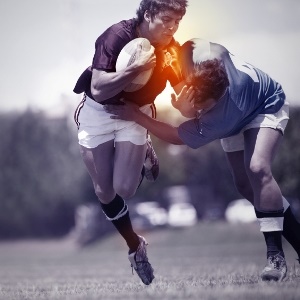
Everyone from well-conditioned athletes to weekend warriors can suffer a sports injury.
Weakness in the muscles, ligaments and tendons following vigorous exercise is often caused by inadequate fitness and a failure to warm-up properly as well as engaging in an activity you’re not properly conditioned for yet. This is often a cause of injury.
When muscles are not used regularly muscle wasting can occur, meaning the muscle fibres have become weakened, so when you do attempt to engage in vigorous exercise beyond your physical capability you may feel tired quickly and this can lead to injury.
The good news however is that with regular exercise and training the muscles will adapt and strengthen. Poor flexibility is another factor in unconditioned athletes behind a sports-related injury.
Flexibility is important because it affects how the body moves. Muscles work together to create smooth movement, so if there is tightness or inflexibility in one muscle it can directly affect the opposing muscle and limit range of motion, which in time can weaken the muscles and the joint.
Over time these muscle imbalances can affect posture and can cause injury.
The best way to improve flexibility is through regular stretching exercises, either static or dynamic. If you struggle with flexibility these should be a daily part of your routine. A thorough warm-up is also essential to prepare the muscles and joints for exercise.
There are, however, different causes behind different sports injuries. These are the most common:
Overtraining
Simply put, this is doing too much, too often with insufficient rest between. A lack of adequate recovery time coupled with amplified intensity of training is the most common cause of overtraining.
Symptoms include:
- Excessive fatigue
- Troubled sleep
- Inability to concentrate
- Inability to perform the exercise or sport with the correct technique.
A physiological sign of overtraining is also an increased resting heart rate. The best way to avoid overtraining is to ensure adequate rest between sessions.
Overuse
Repetitive strain injuries are caused by repeated actions which apply pressure to a certain group of muscles, joint or area of soft tissue.
They usually worsen over time and include injuries such as tennis elbow, golfer’s knee, thrower’s shoulder (impingement syndrome), plantar fasciitis and jumper’s knee (patellar tendonitis).
Symptoms include:
- Gradual pain which worsens over time, sometimes with swelling and/or bruising. Ensuring adequate rest between sessions is the best way to avoid an overuse injury.
Improper warm-up
Failure to perform a proper warm-up can put you at risk for injury as the muscles and joints are not prepared for exercise. A warm-up is necessary to increase body temperature and circulation of blood to the muscles.
A 15-20 minute warm-up should include a combination of stretching and cardiovascular exercises to prepare the body for exercise, increases performance levels and helps to prevent injuries.
Poor technique
Any exercise or sport which is performed repetitively with bad form is a recipe for injury.
Over time the symptoms of injuries being caused by improper technique will be exacerbated and can either lead to a more serious condition or result in more acute injuries.
The best way to avoid repeatedly performing an exercise/sport with the incorrect technique is to make sure you use a professional coach or trainer to show you the correct way to do things from the beginning and to ensure you’re wearing to appropriate clothing, shoes and using the right equipment.
Impact
Perhaps the hardest to avoid, sports injuries caused by impact are most common in contact sports such as football, rugby and boxing etc.
The impact of coming into hard contact with another person/object can force unnatural or unexpected twisting and quick direction-change which can in turn cause damage to connective tissue or even joint dislocation.
Common injuries here include cuts, bruising, head injuries, muscle pain and dislocated joints, spinal injuries, ligament and tendon damage, fractures and head and spinal injuries.
As impact and contact is often a requirement of many sports the only way to reduce the risk is to wear protective clothing if possible, such as shin pads or helmets.
Read more:
References:
Handout on Health: Sports Injuries: NIH Publication No. 13–5278; http://www.niams.nih.gov/Health_Info/Sports_Injuries/default.asp#ra_2
Sports Injuries; Mediline Plus ( 2 October 2014); https://www.nlm.nih.gov/medlineplus/sportsinjuries.html#summary
Sports Medicine Information: (2009) Causes of sports injuries; http://www.nsmi.org.uk/articles/causes-sports-injuries/index.html




 Publications
Publications
 Partners
Partners















